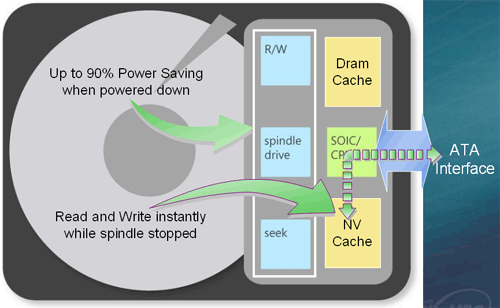WinHEC 2005 - Keynote and Day 1
by Derek Wilson & Jarred Walton on April 26, 2005 4:00 AM EST- Posted in
- Trade Shows
Hybrid Hard Drives
If new and improved firmware management doesn't strike your fancy, Microsoft is working together with Samsung and others to create a new breed of hard disk drive. You may have noticed a slide earlier mentioning the potential for "hybrid hard drives". The basic premise of the hybrid hard drive will be the inclusion of non-volatile flash ram inside the drive itself.Though it hasn't made a great deal of headway yet, Microsoft is really hoping this idea will take off. Gaining support for this technology will round out Longhorn's disk read caching scheme. The aggressive read caching Longhorn does is able to minimize disk accesses for reads by moving large amounts of data into RAM. Unfortunately, using system memory as a writeback cache is not a very feasible (or safe) option. In order to cache disk writes, fast, solid state, non-volatile RAM can be used.
Rather than shove this NVRAM on the motherboard and add a level of complexity to the rest of the system, Microsoft and others have determined that giving hard drive manufacturers full control over the use of NVRAM and caching will allow the rest of the system to operate as if nothing has changed. With the hybrid hard drive managing its own 64MB to 128MB writeback cache, the OS need not worry about what is going on internally with the drive.

The upside to all this is that normal usage models show that average users don't usually write more than 64MB every 10 minutes. This means that the average case may see zero writes hitting the hard drive for 10 minutes, and possibly more with the 128MB solution. Combined with the read cache built into Longhorn, we could see zero disk accesses for 10 to 15 minutes on a heavily utilized system once the OS and applications have initialized. This could mean very large thermal and power savings on notebook drives. Microsoft talked about dropping average drive power consumption over 50%.
In addition to keeping disks turned off on notebook applications, with no parts moving there is less chance for failure. This could help avoid issues that even today's accelerometers can't avoid. An added benefit is also faster resume from hibernation and quick boot time. The system is able to store boot data in the NVRAM. Upon startup, the BIOS is able to access this data without waiting at all for the hard drive to spin up. By the time the system is finished with NVRAM, the drive will be at full speed and ready to continue loading the OS.
There was some talk about hybrid HDDs improving MTBF (mean time before failure), but we will have to wait and talk to the disk manufacturers about this one. It seems counter intuitive that spinning up and powering down the disk more often will do enough to decrease wear on the drive as a whole. The heads will benefit, but how will the added wear on the spindle affect failure rates?
Other questions include the speed and cost of flash RAM proposed for inclusion in hybrid disks. Today's flash RAM is at least an order of magnitude slower than hard drive speeds. Microsoft says they expect 1 nand Flash to reach speeds nearing 100MB/s by the time hybrid disks see the market. They also expect this Flash RAM to be relatively cheap. We aren't so optimistic at this point, but you never know. It may seem enough of an advantage to a company like Samsung (who makes disks and Flash RAM) to really push costs to a point where hybrid hard drives are feasible.
We aren't quite sure we like the idea of windows aggressive approach to caching yet, but it seems to have worked well for OS X thus far. Only time will tell if Microsoft's approach is as good as Apple's.










36 Comments
View All Comments
nastyemu25 - Tuesday, April 26, 2005 - link
uh, "readily available"Viditor - Tuesday, April 26, 2005 - link
A quick note:"and with the largest readily available DIMMs currently coming in at 2 GB in size"
I believe that Samsung, AMD and MSoft were showing 4GB Registered Dimms at the show...
http://home.businesswire.com/portal/site/google/in...
Shinei - Tuesday, April 26, 2005 - link
What makes Microsoft think they know how to use video card memory better than the hardware creators and their respective driver teams? If their memory management in Windows XP is any indication, I imagine everyone will need 1536MB video cards just to play Half-Life 1... And no, that's not a typo.AtaStrumf - Tuesday, April 26, 2005 - link
he, he, HEC = JOKE in my languageThere's your explanation Kristopher ;-)
KristopherKubicki - Tuesday, April 26, 2005 - link
Who wrote those MS slides!Page 1 "An" Historical... ????
Page 6 "Compute" Cluster Edition....
Usually its bad to get the slides wrong on Day 1 of your own event!
Kristopher
Icehawk - Tuesday, April 26, 2005 - link
I'm up too early!